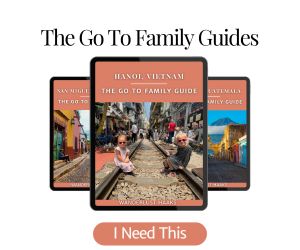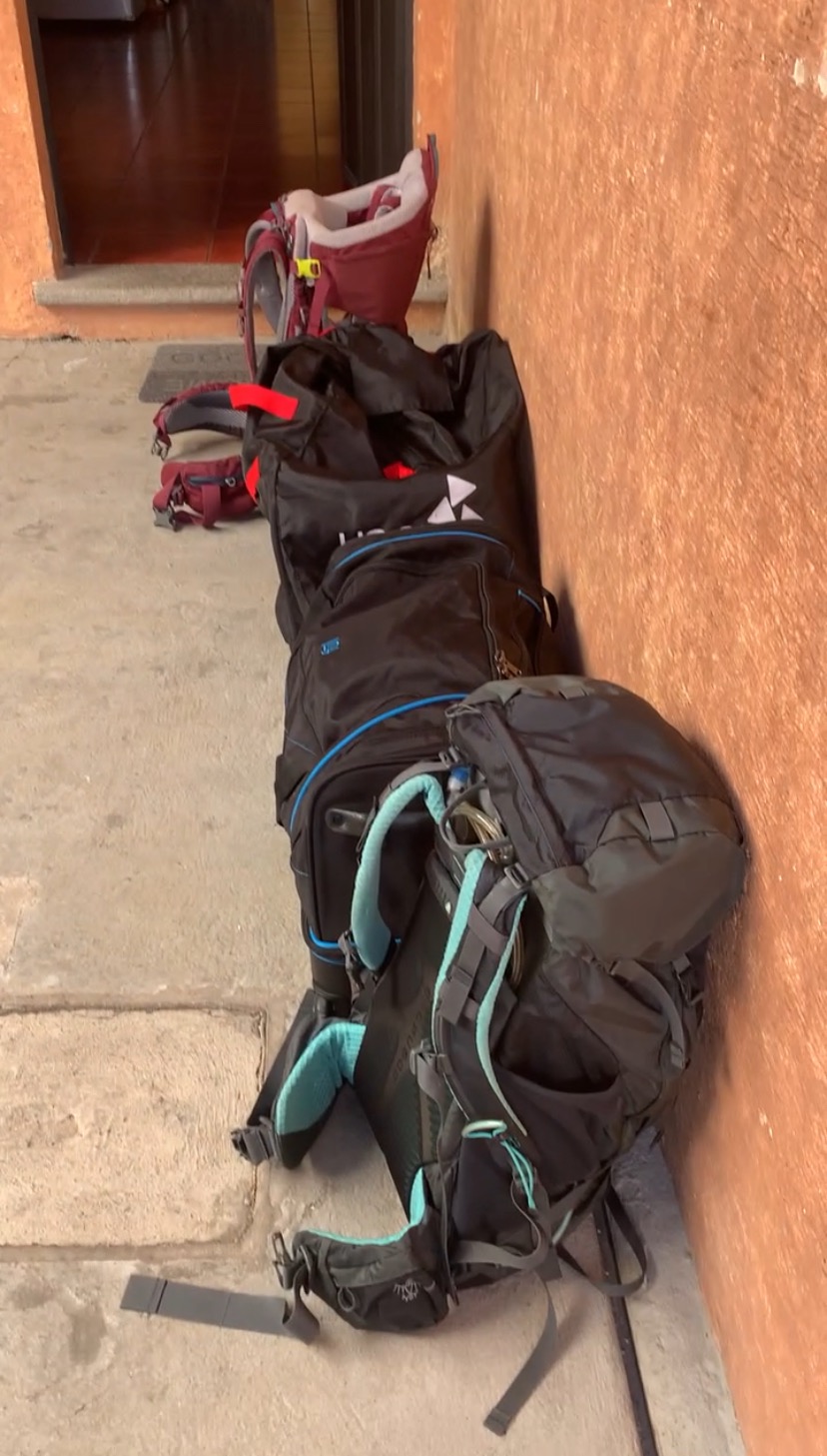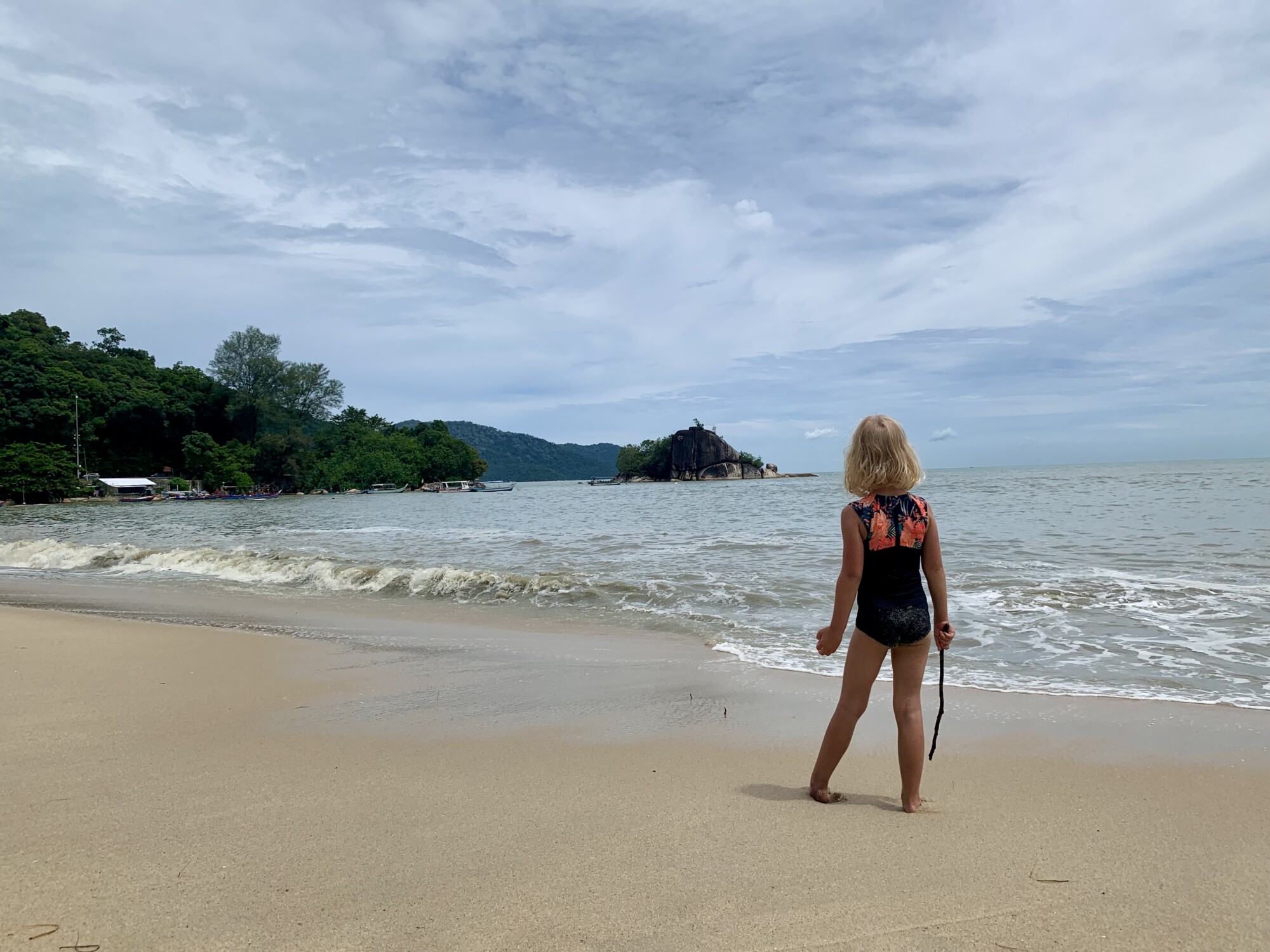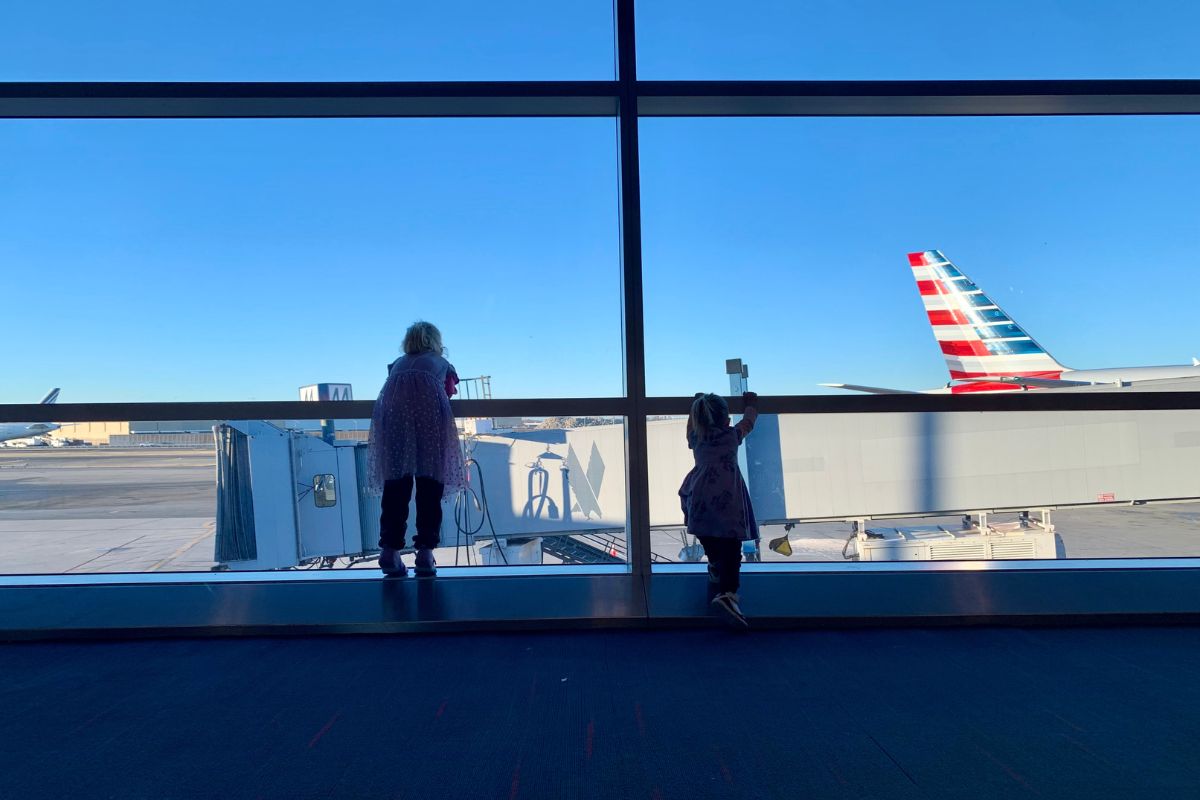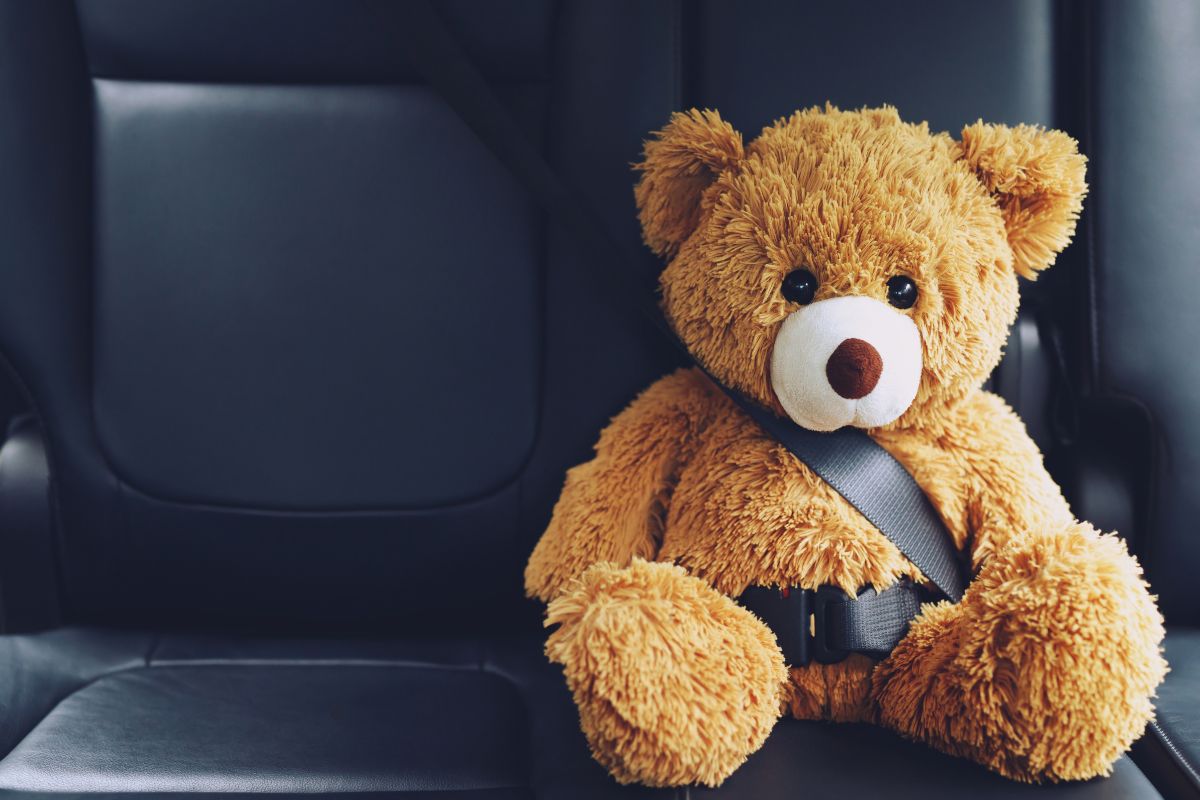When we first started traveling with kids, the sheer amount of stuff we thought we needed was overwhelming. Between child carriers, diaper bags, toys, extra clothes, and gear for every possible scenario, it felt like we were moving our entire house every time we went on a trip. It wasn’t just the physical burden of carrying all this stuff—it was the mental load of keeping track of everything. We quickly realized that this level of overpacking wasn’t just inconvenient; it was exhausting. Minimalist packing completely changed that for us.
The Overpacking Struggle
Packing for a family trip often feels like preparing for the apocalypse. We used to pack “just in case” items for every imaginable scenario—extra outfits for spills, backup toys for tantrums, and even small appliances like a bottle warmer or portable fan. These items piled up quickly, forcing us to use larger luggage, which then required bigger vehicles when renting cars or navigating public transportation. And let’s not forget the frustration of hauling strollers and oversized suitcases through narrow streets in older cities or struggling with multiple bags through busy airports.
When you’re bogged down with excessive luggage, travel becomes about logistics rather than experiences. We often felt stressed about keeping track of everything and dreaded the chaos of unpacking and repacking at every stop. That’s when we decided there had to be a better way.
Our Experience with Minimalist Packing
We eventually decided to simplify. For a three-month trip, we limited ourselves to one suitcase, one backpack, and one child carrier. It made a world of difference. We could navigate cobblestone streets, hop on and off public transportation, and change locations quickly without the stress of lugging heavy bags around.
Minimalist packing also forced us to adapt and embrace local experiences.
Tip: If you’re new to minimalist packing, start with a shorter trip and leave behind a few items you think you might not need. You’ll quickly discover what’s truly essential.
The Minimalist Mindset: Packing Smarter, Not Harder
Minimalist packing begins with a mental shift. It’s not about deprivation or going without essentials; it’s about prioritizing what truly matters. Instead of asking yourself, “What might I need?” the better question is, “What can I live without?” By focusing on what’s necessary, you can create a more streamlined, stress-free packing experience. Here’s how we’ve embraced this mindset as a family and how you can do the same.
Step 1: Make a List for Each Person
The key to minimalist packing is preparation. For every trip, we create a list for each family member. This ensures we stay focused on essentials and avoid the chaos of last-minute packing. Our lists typically include:
-
Clothing: Mix-and-match outfits that are weather-appropriate and versatile. (More on this in the capsule wardrobe section.)
-
Toiletries: Only the basics. For items like shampoo, conditioner, or toothpaste, we often buy them at our destination. This approach not only saves space but also avoids the hassle of TSA inspections.
-
Comfort Items: If our kids have specific needs—like a favorite stuffed animal or blanket—we include those, but we limit it to one or two comfort items per child.
Step 2: Involve the Kids
One of the biggest challenges of packing for a family trip is managing your kids’ expectations. Children are naturally attached to their belongings, and the idea of leaving things behind can sometimes cause anxiety. However, involving them in the packing process can make all the difference.
How We Do It:
-
Give Them a Say: We let our kids pick one or two toys, books, or art supplies to bring. By giving them ownership over the decision, they feel more in control and are less likely to complain about what’s left behind.
-
Explain the Why: We talk to our kids about why we’re packing lightly. For example, we explain that traveling with fewer things makes it easier to explore, play, and move around. We emphasize the fun experiences they’ll have on the trip, which shifts their focus from what they’re leaving behind to what they’re gaining.
-
Set Clear Limits: We give our kids a designated bag for their items. Anything that doesn’t fit in the bag stays home. This teaches them to prioritize and reinforces the value of minimalism.
Step 3: Rethink “Just in Case” Items
One of the hardest parts of minimalist packing is resisting the urge to bring “just in case” items. Whether it’s extra outfits, backup toys, or specialized gear, these items can quickly clutter your suitcase. Instead, we ask ourselves:
-
How often do we use this item at home? If it’s not something we use daily or weekly, it’s probably not essential for the trip.
-
Can we buy or borrow this item if needed? For example, if you forget a beach towel, most destinations have inexpensive options available.
-
What’s the worst-case scenario if we don’t bring it? Most of the time, the answer isn’t as catastrophic as we imagine.
Step 4: Focus on Experiences Over Possessions
Minimalist packing is about more than just lightening your suitcase—it’s a mindset that prioritizes experiences over things. Here’s why this matters:
-
Less Luggage, More Freedom: When you’re not weighed down by excessive baggage, it’s easier to be spontaneous. You can hop on public transportation, explore cobblestone streets, or take a last-minute excursion without worrying about your gear.
-
Quality Family Time: With fewer toys and gadgets, kids naturally gravitate toward engaging with their environment—and with you. We’ve found that minimalist packing fosters deeper family connections because we’re all more present in the moment.
-
A Valuable Life Lesson: Teaching kids to focus on experiences rather than possessions is a gift that extends far beyond travel. It helps them develop gratitude, creativity, and adaptability.
Pro Tip: To reinforce this mindset, we keep the conversation going even after the trip. We ask our kids questions like, “What was your favorite part of the trip?” or “What did you love most about exploring the park?” These reflections help them appreciate the experiences over the things they left behind.
Essentials Only: What to Pack for Kids (and What to Leave Behind)
Packing for kids doesn’t have to feel like a juggling act. The key is to focus on versatile, multi-purpose items that will actually get used. Overpacking often leads to unnecessary stress—both in carrying extra bags and trying to manage all the “what ifs” in your head. After traveling with young kids, we’ve narrowed down a practical, minimalist packing list that keeps things simple while ensuring everyone has what they need.
Must-Have Items for Kids
When it comes to essentials, think of items that serve multiple purposes and are easy to pack. Here’s what we always include in our bags:
Clothing:
-
Two of Each Type: Pack two long-sleeve shirts, two short-sleeve shirts, two pairs of pants, and two pairs of shorts for each child. These can be easily mixed and matched for multiple outfits, making it simple to adapt to changing weather.
-
Layering: Lightweight sweaters or hoodies can double as layers for chilly mornings and evenings.
-
Outerwear: A lightweight jacket for each child—something that’s waterproof if you expect rain. Have them wear their jackets and bulkier items (like boots) during travel to save space in your suitcase.
-
Shoes: Each child gets one sturdy pair of shoes (like sneakers or hiking shoes) and a pair of sandals. For toddlers, something like Keen sandals works great because they’re durable and versatile.
Sleep Essentials:
-
Inflatable Toddler Bed: If you’re traveling with a toddler, this compact solution provides a cozy place to sleep without taking up much space. It’s perfect for hotels or Airbnb stays.
-
Portable Sound Machine: A must-have for kids who are sensitive to noise. It creates a familiar sleep environment no matter where you’re staying, making bedtime easier.
Gear:
-
Child Carrier: For toddlers, a child carrier is invaluable, especially if you’re planning to explore places that aren’t stroller-friendly, like cobblestone streets, hiking trails, or crowded markets.
Entertainment:
-
Books: Before the trip, we purchase a few new paperback books. Paperbacks are lightweight, and the novelty of a new story keeps the kids engaged.
-
iPad or Tablet (for Emergencies): Pre-download movies, games, or educational apps to keep them entertained during long flights, layovers, or unexpected delays.
-
Novelty Toys: Small, compact toys—like an erasable drawing board, travel-sized puzzles, or sticker books—are great for keeping kids busy without taking up much space.
-
Art Supplies: A pack of crayons and a small notebook go a long way for creative kids. Just make sure the art supplies are mess-free (e.g., no markers that could leak).
What to Leave Behind
As tempting as it is to pack “just in case” items, most of them end up unused and become dead weight. Here’s what we’ve learned to leave behind:
Excessive Clothing:
If your child doesn’t wear something every day at home, chances are they won’t need it on vacation. Skip the “extra extras” like five pairs of pajamas or formal outfits (unless you know you have a specific event to attend).
Bulky Toys:
Kids don’t need a suitcase full of toys. Travel is often exciting enough to keep them entertained, especially if you’re spending time outdoors. A few small toys and a lot of outdoor exploration go much further than lugging around stuffed animals or large playsets.
Redundant Gear:
Skip packing multiple strollers, travel cribs, or high chairs unless absolutely necessary. Many accommodations have baby-friendly options available for rent or on-site. Research ahead of time to see if your destination offers gear rentals—this can save you from carrying large, cumbersome items.
Non-Essential Toiletries:
Diapers, wipes, and formula are often available at your destination, so pack only enough for the first day or two. Buying these items locally saves valuable luggage space. The same goes for items like baby shampoo or body wash—grab travel-sized versions or pick them up upon arrival.
Pro Tip: The Power of Novelty
Before every trip, we buy a few new items specifically for the journey. Whether it’s a paperback book, a small toy, or a fun coloring activity, the novelty factor keeps kids engaged and excited. These items are easy to pack and work wonders for moments when your child needs a distraction, such as during a long flight or while waiting for food at a restaurant.
Why This Works:
Kids are naturally drawn to new things. A fresh sticker book or a toy they haven’t seen before captures their attention in a way their usual toys don’t. By introducing these items sparingly throughout the trip, you can stretch out their entertainment value.
Additional Tips for Packing Essentials
-
Opt for Dual-Purpose Items: Look for items that can serve more than one function, like a scarf that doubles as a blanket or a jacket that can be used as a pillow.
-
Pack for Activities, Not Scenarios: Instead of packing for every possible situation, focus on the activities you know you’ll be doing. If you’re heading to the beach, prioritize swimsuits and sun hats instead of raincoats and boots.
The Capsule Wardrobe Approach for Families
A capsule wardrobe is a game-changer when it comes to minimalist packing, especially for families. It’s a simple yet highly effective way to ensure you have enough clothing options without overloading your suitcase. The concept is straightforward: pack a small number of versatile clothing items that can be easily mixed and matched. This approach not only saves space but also makes it easier to plan outfits, adapt to different weather conditions, and keep things organized.
Why Use a Capsule Wardrobe for Travel?
Traveling with kids often means dealing with spills, messes, and unpredictable weather, which can tempt parents into overpacking. But a capsule wardrobe eliminates the need for “just in case” outfits by focusing on versatile, practical clothing that serves multiple purposes.
Benefits of a Capsule Wardrobe:
-
Saves Space: By packing fewer items, you leave room for essentials like snacks, toiletries, and souvenirs.
-
Reduces Stress: With fewer items to choose from, getting dressed in the morning becomes a breeze.
-
Adapts to Activities: Capsule wardrobes are designed to handle various scenarios, from hiking and exploring to casual outings and family dinners.
-
Encourages Creativity: Kids (and adults) learn how to mix and match their outfits, making the most out of what they have.
What We Pack for a Family Capsule Wardrobe
For the Kids:
We focus on packing 2-3 of each clothing item per child. These items are chosen to be versatile and durable, ensuring they can handle a variety of activities and weather conditions.
-
Tops:
-
2-3 short-sleeve shirts.
-
2-3 long-sleeve shirts.
-
A lightweight sweatshirt or hoodie for layering.
-
-
Bottoms:
-
2-3 pairs of pants.
-
2 pairs of shorts.
-
-
Outerwear:
-
One lightweight, waterproof jacket. This is essential for unexpected rain or cooler weather and can be worn on travel days to save suitcase space.
-
-
Sleepwear:
-
1 pair of comfortable pajamas.
-
-
Swimwear:
-
One swimsuit per child if traveling to warm destinations or near water.
-
For the Parents:
The principles are the same, but adult wardrobes may include slightly fewer items due to less mess (hopefully!).
-
Tops:
-
2-3 T-shirts.
-
2 long-sleeve shirts.
-
-
Bottoms:
-
2 pairs of pants (one pair of jeans or travel pants, one lighter option like joggers).
-
1-2 pairs of shorts (depending on the climate).
-
-
Outerwear:
-
A lightweight jacket or cardigan that can double as a layer for evenings.
-
-
Shoes:
-
One sturdy pair of walking shoes (like sneakers or hiking boots).
-
One pair of sandals.
-
Packing Tips for a Capsule Wardrobe
To make the most out of your capsule wardrobe, follow these packing tips:
Stick to a Color Palette:
-
- Choose neutral or complementary colors so that all items can be easily mixed and matched. For example, stick to blacks, whites, grays, and blues, with one or two pops of color.
Choose Multi-Purpose Items:
-
- Pack items that serve more than one purpose. For example, leggings can be used for lounging, layering, or outdoor activities.
Layer Strategically:
-
- Layering is the secret to handling a variety of weather conditions with fewer items. For instance, a long-sleeve shirt paired with a lightweight jacket works well for cooler mornings or evenings.
Use Travel Days Wisely:
-
- Have your kids wear their bulkiest items, like jackets and boots, on travel days. This not only frees up suitcase space but also keeps them warm in air-conditioned airports or planes.
Roll, Don’t Fold:
-
- Rolling clothes saves space and reduces wrinkles. You can also use packing cubes to keep items organized by type or family member.
-
Don’t Forget Accessories: Lightweight accessories like scarves, hats, and gloves (if needed) can add extra functionality to a small wardrobe. These items are great for layering or protecting against the elements without taking up much space.
-
Weather Considerations
While a capsule wardrobe works well for most trips, you’ll need to make slight adjustments based on the climate:
-
-
Cold Weather: Pack additional layers like thermal shirts, leggings, and gloves. Opt for a heavier jacket that can handle colder temperatures.
-
Warm Weather: Focus on breathable fabrics like cotton and linen. Add a wide-brimmed hat and UV-protective swimwear for sunny days.
-
Packing Techniques to Maximize Space
Efficient packing is the foundation of minimalist travel. By using space-saving strategies, you can fit everything you need into a smaller suitcase or backpack without sacrificing functionality. Whether you’re packing for a weekend getaway or a months-long adventure, these techniques will help you stay organized, save space, and avoid the stress of overpacking.
1. Use Packing Cubes for Organization and Space Efficiency
Packing cubes are one of the simplest and most effective tools for organizing a suitcase. These lightweight, zippered compartments allow you to divide clothing and accessories by category or family member, making it easy to locate items when you need them.
How We Use Them:
-
For the kids, their clothes are so small that we only need one packing cube to hold clothing for both children.
-
For adults, we use separate cubes for categories like tops, bottoms, and undergarments. This makes unpacking at your destination a breeze.
-
Compression packing cubes are particularly useful for bulkier items, as they can reduce the volume of clothes like jackets or sweaters by squeezing out excess air.
Why They Work: Packing cubes not only save space but also help you stay organized. Instead of rummaging through your suitcase to find a specific item, you can simply grab the cube labeled “shirts” or “kids’ clothes.” This is especially helpful when traveling with a family and trying to keep everyone’s belongings in order.
2. Roll, Don’t Fold
Rolling clothes is a tried-and-true packing technique that saves space and minimizes wrinkles. It works particularly well for lighter fabrics like cotton, polyester, and blends.
How to Roll Clothes:
-
Lay the item flat and smooth out any wrinkles.
-
Fold it in half lengthwise (if needed), then roll it tightly from one end to the other.
-
Place the rolled item into your suitcase or packing cube.
Best Items to Roll:
-
T-shirts
-
Pants made from lightweight materials (e.g., joggers, leggings)
-
Dresses and skirts
-
Undergarments and socks
What Not to Roll:
-
Jeans or other heavy fabrics that don’t compress well. These are better folded flat and placed at the bottom of the suitcase.
Pro Tip: Rolling clothes works particularly well with packing cubes, as it allows you to fit more items into a smaller space while keeping them organized.
3. Compress Bulkier Items
For bulkier items like jackets, sweaters, and thicker pants, compression bags or compression cubes are invaluable. These tools help reduce the volume of larger items, freeing up space for other essentials.
How to Use Compression Bags:
-
Place the bulky item into the bag.
-
Seal the bag and use the built-in valve or zipper to squeeze out excess air.
-
Lay the compressed bag flat in your suitcase.
Compression bags are especially helpful for winter travel, where bulkier clothing is unavoidable. They’re also great for items like baby blankets or toddler bedding.
4. Organize by Category
An organized suitcase is an efficient suitcase. Separating items by category makes it easier to find what you need without unpacking the entire bag.
How We Organize:
-
Clothing: Pack tops, bottoms, and undergarments in separate packing cubes.
-
Shoes: Place shoes in a separate shoe bag or plastic bag to keep them from dirtying your clothes. Stuff socks or small items inside the shoes to save additional space.
-
Toiletries: Use a toiletry bag with multiple compartments to keep everything organized and prevent spills.
Pro Tip: Place frequently used items, like pajamas or a change of clothes, on top of your suitcase for easy access upon arrival.
5. Pack Heavier Items at the Bottom
When packing a suitcase, place heavier items, like shoes and toiletries, at the bottom (the part closest to the suitcase wheels). This ensures the suitcase remains stable and easy to roll. Lighter items, like clothing, should go on top.
Why This Works: Distributing weight evenly prevents your suitcase from tipping over and makes it easier to maneuver, especially when navigating airports or cobblestone streets.
6. Use Every Inch of Space
Maximize the available space in your suitcase by filling in gaps with small items. For example:
-
Stuff socks, underwear, or small accessories into shoes or the corners of your bag.
-
Roll belts and place them along the edges of the suitcase.
-
Use the space inside hats to store smaller items like scarves or gloves.
Pro Tip: If you’re bringing a backpack or diaper bag as a carry-on, use it to store overflow items like snacks, electronics, or an emergency change of clothes for kids.
7. Avoid Overpacking Heavy Fabrics
While it may be tempting to bring jeans or bulky sweaters, these items take up significant space and often aren’t necessary. Instead:
-
Opt for lightweight, quick-dry fabrics like cotton, polyester, or merino wool.
-
Layer thinner items to stay warm instead of relying on a single heavy piece.
Pro Tip: If you must bring jeans or a heavier coat, wear them during travel to save suitcase space.
8. Plan for Laundry
One way to pack less is to plan for laundry during your trip. Many hotels, vacation rentals, and Airbnbs offer laundry facilities, and even a quick sink wash for small items like socks or underwear can help extend their use.
What to Pack for Laundry:
-
Detergent sheets so no spillage in your bag.
-
A laundry/trash bag for dirty clothes to keep them separate from clean items.
Why This Works: By doing laundry mid-trip, you can pack fewer clothing items overall and reuse key pieces multiple times.
Pro Tip: What We’ve Learned from Trial and Error
-
Test Your Packing Plan: Before your trip, pack everything and take a quick test run. Can you zip up your suitcase without straining? If not, reevaluate and remove a few items.
-
Invest in Quality Gear: Durable, lightweight suitcases and packing cubes make a huge difference in how efficiently you can pack.
Minimalist Packing Tips for Different Types of Travel
Packing minimally can vary depending on the type of trip you’re taking. Whether you’re hitting the open road, catching a flight, or heading abroad, the principles of minimalist packing remain the same—focus on essentials and organization. However, each type of travel comes with unique challenges that require specific strategies. Here’s how to adapt minimalist packing to different types of trips.
1. Road Trips
Road trips offer more flexibility when it comes to luggage, but that doesn’t mean you should overpack. The key to a successful road trip is accessibility—having what you need within arm’s reach while keeping the car organized.
What to Pack:
-
Essentials Bag: Use a small bag or tote for items you’ll need during the drive. Include:
-
Snacks (both healthy options and treats).
-
Refillable water bottles for everyone.
-
Entertainment like coloring books, small toys, or a tablet with pre-downloaded content.
-
A first-aid kit for minor scrapes or emergencies.
-
-
Emergency Change of Clothes: Accidents happen, especially with kids. Keep a change of clothes for each child easily accessible, along with a plastic bag for soiled clothing.
-
Comfort Items: A small blanket or travel pillow for naps during long drives.
Organization Tips:
-
Use packing cubes or zippered pouches to separate items by category (e.g., snacks, clothes, entertainment).
-
Place frequently used items in the car’s console or seat-back organizers for easy access.
-
Pack lighter luggage in the trunk to keep the main seating area clutter-free.
Pro Tip: Avoid packing too many snacks that require refrigeration. Cutting up carrots or apples beforehand make a great airport snack.
2. Flights
Flying with kids can be challenging, especially when you’re trying to minimize what you bring. The key is to strategically pack a carry-on with everything you’ll need during the flight while keeping checked luggage light.
What to Pack in Your Carry-On:
-
Entertainment: Bring compact items to keep kids entertained, such as:
-
A Yoto player or tablet with pre-downloaded audiobooks, movies, and apps.
-
A few new toys or activity books to capture their attention.
-
-
Snacks: Airlines may not always have kid-friendly food options, so pack a variety of snacks. Include non-messy options like string cheese, pouches, or crackers.
-
Essentials: Include:
-
One change of clothes for each child.
-
Diapers, wipes, and a portable changing pad (if needed).
-
A refillable water bottle (fill it after passing security).
-
-
Comfort Items: A lightweight blanket or their favorite stuffed animal to help them relax during the flight.
Checked Luggage Tips:
-
Stick to the essentials and use packing cubes to maximize space.
-
Avoid overpacking clothes; plan to do laundry during your trip if it’s a longer stay.
-
Place heavier items like shoes at the bottom of your suitcase to keep it stable.
Pro Tip: Always pack essential medications, documents, and valuables in your carry-on. Checked luggage delays can happen, and it’s better to be prepared.
3. International Travel
International travel often requires more planning due to cultural considerations, varying climates, and extended stays. Minimalist packing becomes even more important when dealing with long flights, multiple destinations, or public transportation.
What to Pack:
-
Essentials: Stick to versatile clothing that can be layered. For example:
-
Lightweight pants and long-sleeve shirts for sun protection or cooler evenings.
-
Comfortable walking shoes that work for various terrains.
-
A scarf or shawl for layering or adhering to cultural norms in certain regions.
-
-
Toiletries: Limit liquids to travel-sized containers to comply with international security regulations. Buy larger items like shampoo or sunscreen at your destination.
-
Electronics: Don’t forget universal power adapters or voltage converters if needed for your devices.
-
Documents: Keep passports, visas, travel insurance, and copies of important documents in a secure, waterproof pouch.
Cultural Considerations:
-
Research the dress codes and customs of your destination. For example, some countries may expect more modest clothing, while others prioritize practicality.
-
Avoid flashy jewelry or expensive-looking accessories to minimize the risk of theft.
Pro Tip: Pack a lightweight foldable daypack for excursions or day trips. It’s perfect for carrying snacks, water, and other essentials while leaving your main luggage at your accommodation.
Packing for Weather and Activities
Adapting your minimalist packing for specific activities or weather conditions can make a big difference. Here’s how to prepare:
Cold Weather:
-
Pack thermal layers and one good-quality jacket for each person.
-
Opt for merino wool or fleece materials that are lightweight but warm.
-
Include gloves, hats, and scarves, but keep these items compact.
Warm Weather:
-
Focus on breathable, lightweight fabrics like cotton or linen.
-
Include a wide-brimmed hat, sunscreen, and UV-protective swimwear.
-
Bring a reusable water bottle with a filter if traveling to areas where clean water isn’t readily available.
Outdoor Activities:
-
Pack sturdy, multi-purpose shoes suitable for hiking or walking.
-
Bring a compact rain jacket for sudden weather changes.
-
Include a lightweight backpack for carrying water, snacks, and gear during excursions.
Managing Kids’ Needs Without Overpacking
Traveling with kids is always an adventure, but their unpredictability can make packing feel like a monumental task. You might be tempted to bring everything they could possibly want or need, but the truth is, you don’t need to pack the entire playroom. Managing kids’ needs while traveling is about being intentional with what you bring. Here’s how to keep them entertained, comfortable, and happy without overpacking.
1. Keep Entertainment Simple and Compact
Kids often need something to keep them engaged during long car rides, flights, or downtime at the hotel. The key is to choose lightweight, versatile entertainment options that don’t take up much space but pack a lot of fun.
What We Bring:
-
Yoto Player: This screen-free device plays audiobooks, music, and educational content, keeping kids entertained without overstimulating them. It’s lightweight, portable, and a lifesaver on long flights or car rides.
-
Coloring Activities: A small notebook or coloring book and a pack of crayons or colored pencils are perfect for creative play. Look for mess-free options to avoid dealing with marker stains or paint spills.
-
Lightweight Books: Before each trip, we buy a couple of new paperback books. The novelty factor keeps kids engaged, and paperbacks are easy to pack.
-
Novelty Toys: Bring a couple of small, new toys that are specifically for the trip. Think travel-friendly puzzles, fidget toys, or mini playsets. Unveiling a “new” toy during the journey can capture their attention and buy you some much-needed quiet time.
2. Always Have Snacks Handy
If there’s one thing you should never skimp on while traveling with kids, it’s snacks. Hunger is one of the quickest ways to trigger a meltdown, so keeping a variety of snacks on hand can save the day. That said, you don’t need to pack your entire pantry.
What We Pack:
-
Non-Messy Options: Granola bars, crackers, string cheese, fruit pouches, and trail mix are all great options that won’t make a huge mess in the car or plane.
-
Special Treats: Pack a few “fun” snacks like gummies, cookies, or candy for emergencies. Sometimes, a quick treat can distract or calm a cranky child.
-
Refillable Water Bottles: Bring a reusable water bottle for each child to keep them hydrated. Opt for leak-proof bottles to avoid spills.
Pro Tip: If space is tight, plan to restock snacks as you go. Most destinations have grocery stores or markets where you can grab more supplies.
3. Set Strict Packing Limits
It’s easy to get carried away when packing for kids, but we stick to one golden rule: Everything must fit into one designated bag. This rule forces us to prioritize and prevents us from overpacking.
How We Do It:
-
Dedicated Bags: The kids get one small backpack or carry-on. All their toys, books, and activities must fit into this bag. If it doesn’t fit, it doesn’t come.
-
Share Items: Instead of packing a separate coloring book or toy for each child, we choose items they can share. For example, one pack of crayons and one sticker book can go a long way.
-
Focus on Versatility: Choose items that serve multiple purposes, like a scarf that can double as a blanket or a toy that can be used in different ways (e.g., stacking, building, or imaginative play).
4. Prepare for Emergencies Without Overpacking
Even with the best planning, unexpected situations will arise. Whether it’s a spilled drink, a delayed flight, or a tantrum, being prepared can make all the difference.
What to Pack for Emergencies:
-
Change of Clothes: Keep one full outfit for each child in your carry-on or easily accessible bag. Include underwear and socks.
-
Basic First Aid Kit: Pack items like band-aids, antiseptic wipes, fever reducers, and any prescription medications your child needs.
-
Wipes and Hand Sanitizer: These are must-haves for cleaning up messes or sticky hands on the go.
-
Comfort Items: A favorite stuffed animal, blanket, or pacifier can help soothe a child in stressful situations.
Pro Tip: Keep all emergency items in one bag or pouch so you can grab them quickly when needed.
Conclusion
Minimalist packing is not just about taking fewer items—it’s about intentionally creating space for what matters most during your travels: the experiences, the connections, and the memories. By reducing the clutter and burden of excessive luggage, you free up both physical and mental energy to focus on the moments that truly count.
When you pack minimally, you’re giving yourself the gift of flexibility. You’re able to navigate airports, cities, and even remote destinations with ease. You can spend less time worrying about logistics and more time exploring new places, meeting new people, and enjoying quality moments with your family. Whether it’s taking in the breathtaking view from a mountaintop or laughing with your kids over an unexpected adventure, minimalist packing allows you to be fully present.
The Hidden Benefits of Minimalist Packing
Minimalist packing isn’t just practical—it also has surprising benefits that ripple through your entire travel experience:
-
Less Stress: Without the worry of managing multiple suitcases or keeping track of countless items, you’ll feel a weight lifted from your shoulders (literally and figuratively).
-
Teaching Life Lessons: Packing light teaches kids valuable lessons about prioritizing what’s important, being resourceful, and finding joy in experiences rather than material things.
-
Cost Savings: With fewer bags, you can often avoid checked luggage fees, use smaller rental cars, and skip paying for oversized baggage. Over time, this adds up to significant savings.
-
Environmental Impact: By carrying less, you consume fewer resources during your travels. This is especially true when opting for reusable items, compact gear, and local purchases instead of overstocking beforehand.
Practical Tips for First-Time Minimalist Packers
If you’re new to minimalist packing, it might feel intimidating at first. Here are a few tips to ease into the process:
-
Start Small: Test minimalist packing on a weekend trip before committing to longer vacations. This gives you a chance to practice and refine your packing strategy.
-
Make a Packing List: Write down everything you think you’ll need, then review the list and remove non-essential items. If you don’t use something daily at home, you likely won’t need it while traveling.
-
Trust the Process: It’s easy to feel nervous about leaving items behind, but remember that most destinations have stores where you can buy anything you truly need. Trust that
A Final Thought
The truth is, you won’t remember the extra pair of shoes or the backup outfit you didn’t wear. What you will remember are the memories you made: the time your kids splashed in a foreign fountain, the stunning sunset you watched as a family, or the laughter shared during an impromptu roadside picnic. Minimalist packing creates space—not just in your suitcase but in your life—for these moments to unfold.
So, the next time you’re planning a trip, challenge yourself to pack light. Leave behind the “what ifs” and focus on what you truly need to make your journey memorable. You might just find that minimalist packing isn’t just about travel—it’s a perspective that carries over into how you live your life. And who knows? It might just become the best travel decision you’ve ever made.

